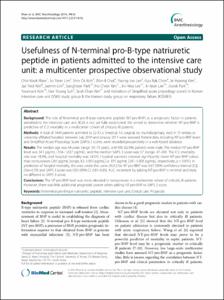KUMEL Repository
1. Journal Papers (연구논문)
1. School of Medicine (의과대학)
Dept. of Internal Medicine (내과학)
Usefulness of N-terminal pro-B-type natriuretic peptide in patients admitted to the intensive care unit: a multicenter prospective observational study
- Keimyung Author(s)
- Choi, Won Il
- Department
- Dept. of Internal Medicine (내과학)
- Journal Title
- BMC Anesthesiology
- Issued Date
- 2014
- Volume
- 14
- Issue
- 1
- Abstract
- BACKGROUND:
The role of N-terminal pro-B-type natriuretic peptide (NT-pro-BNP) as a prognostic factor in patients admitted to the intensive care unit (ICU) is not yet fully established. We aimed to determine whether NT-pro-BNP is predictive of ICU mortality in a multicenter cohort of critically ill patients.
METHODS:
A total of 1440 patients admitted to 22 ICUs (medical, 14; surgical, six; multidisciplinary, two) in 15 tertiary or university-affiliated hospitals between July 2010 and January 2011 were assessed. Patient data, including NT-pro-BNP levels and Simplified Acute Physiology Score (SAPS) 3 scores, were recorded prospectively in a web-based database.
RESULTS:
The median age was 64 years (range, 53-73 years), and 906 (62.9%) patients were male. The median NT-pro-BNP level was 341 pg/mL (104-1,637 pg/mL), and the median SAPS 3 score was 57 (range, 47-69). The ICU mortality rate was 18.9%, and hospital mortality was 24.5%. Hospital survivors showed significantly lower NT-pro-BNP values than nonsurvivors (245 pg/mL [range, 82-1,053 pg/mL] vs. 875 pg/mL [241-5,000 pg/mL], respectively; p < 0.001). In prediction of hospital mortality, the area under the curve (AUC) for NT-pro-BNP was 0.67 (95% confidence interval [CI], 0.64-0.70) and SAPS 3 score was 0.83 (95% CI, 0.81-0.85). AUC increment by adding NT-pro-BNP is minimal and likely no different to SAPS 3 alone.
CONCLUSIONS:
The NT-pro-BNP level was more elevated in nonsurvivors in a multicenter cohort of critically ill patients. However, there was little additional prognostic power when adding NT-pro-BNP to SAPS 3 score.
Keywords: N-terminal pro-B-type natriuretic peptide, Intensive care unit, Critical care, Prognosis
- Keimyung Author(s)(Kor)
- 최원일
- Publisher
- School of Medicine
- Citation
- Chin Kook Rhee et al. (2014). Usefulness of N-terminal pro-B-type natriuretic peptide in patients admitted to the intensive care unit: a multicenter prospective observational study. BMC Anesthesiology, 14(1), 16–16. doi: 10.1186/1471-2253-14-16
- Type
- Article
- ISSN
- 1471-2253
- Appears in Collections:
- 1. School of Medicine (의과대학) > Dept. of Internal Medicine (내과학)
- 파일 목록
-
-
Download
 oak-aaa-00655.pdf
기타 데이터 / 255.26 kB / Adobe PDF
oak-aaa-00655.pdf
기타 데이터 / 255.26 kB / Adobe PDF
-
Items in Repository are protected by copyright, with all rights reserved, unless otherwise indicated.